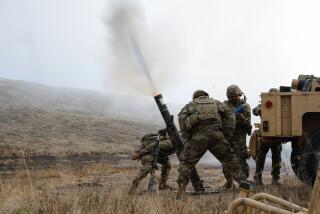Golf Course Suggested for Airport Use : Point Mugu: Terminal would be on base land. The study on proposed civilian-military facility surprises panel and Navy officials.
A plan to develop a civilian-military airport at the Point Mugu Navy base may be imperiled if a consultant’s recommendation--which would put the passenger terminal on Navy property--is followed, members of the committee investigating the proposal said this week.
Members of the Point Mugu Joint Use Airfield Investigative Committee and Navy officials said they were caught off guard by a newly released feasibility study that recommended putting a passenger and air-cargo terminal on a 98-acre, nine-hole golf course on the base.
The Navy has said it will not consider a plan in which military land is used.
Of the three sites considered, the base’s John E. Clark golf course is best-suited for the terminal facility, according to the study by consultants with the Southern California Assn. of Governments. The feasibility study was commissioned by the investigative committee.
Although two other sites were considered, the SCAG report recommended only the golf course site.
The second site was a 64-acre parcel immediately north of the main runway, of which the Navy owns approximately 13 1/2 acres.
The third site, which also totals 64 acres and is on the base’s northeastern border, would involve the use of 14 acres of Navy property.
The second and third options would require the purchase of additional property, including parcels of farmland and parts of a nearby trailer park, the report said. A taxiway to the main runway would also have to be constructed.
Members of the eight-person investigative committee, which includes three county supervisors and several members of local city councils, said they were surprised with the study’s recommendation.
“It may well be a fatal flaw, I don’t know,” said County Supervisor Maggie Kildee. “I’m also a little shocked that someone didn’t think to include the Navy’s warning in the study.”
*
Her colleague on the board, County Supervisor John K. Flynn, agreed, saying that although the golf course may be the logical and best choice for a passenger terminal facility, it would be unwise to pursue the development at that location, given the Navy’s stance.
“I think that it would be a serious political mistake to go after the golf course,” Flynn said. “I think what we should do is go after developing the site closer to the (Pacific Coast) highway and the Air National Guard base. I think that area would be far easier to develop.”
Tim Merwin, chief aviation analyst for SCAG, said that because land just outside the base would have to be purchased and because it is further from the main runway, the golf course was the best choice, despite the Navy’s admonition that it would not give up the property.
Merwin could not explain why the study failed to note the Navy’s opposition to any of its land on the base being developed.
But Merwin and Thousand Oaks City Councilman Frank Schillo said they believed the Navy might ultimately soften its position on the development of land within the base’s perimeter.
“The Navy for years said they didn’t want civilians flying in and out of their airfield and then, suddenly, last year they changed their minds,” Schillo said. “I believe that it’s very possible for them to change their minds on this issue, too. If they don’t, I think we have a problem.”
*
In March 1993, when Rear Adm. Bill Newman, then Point Mugu’s commanding officer, invited county officials to his office to discuss the possibility of developing a joint military and civilian use airfield, he announced that the proposal came with four caveats, said Navy spokesman Alan Alpers.
Alpers said Newman pledged that the Navy would not fund the effort, that private aircraft would not be allowed on the airfield, that the shared use would not affect the base’s military mission and that no Navy land would be involved.
Now, 19 months later, Alpers said the Navy has not changed its mind.
“We were surprised to see the (golf course) recommended as strongly as it was in the report,” said Navy Capt. Tom Boothe, the non-voting chairman of the investigative committee. “The Navy prefers that none of its land be used. It’s not that we like golf so much, it’s the fact that the course represents one of the last sites we have that can be developed by the Navy.”
But because the proposal is still in an embryonic stage, Boothe, who is the base’s public works officer, refused to immediately condemn the study’s recommended terminal locations.
“We are going to jealously guard the land that we have left,” Boothe said. “(The committee) can recommend whatever it wants and we will look at anything they put in front of us. However, that doesn’t mean that we have to accept their recommendations.”
The investigative committee will consider adopting the findings of the first phase of the SCAG feasibility report at its meeting next month. Officials said the second phase of the report, to be issued in late December or early January, will address the proposal’s environmental impact, funding mechanisms and land-planning issues.
Proposed Regional Airport
Three sites at and adjacent to Point Mugu Naval Air Weapons Station are being considered as locations for passenger and air cargo terminals. The navy airfield is being considered for possible joint military-civilian use. Source: Southern California Association of Governments
More to Read
Sign up for Essential California
The most important California stories and recommendations in your inbox every morning.
You may occasionally receive promotional content from the Los Angeles Times.









